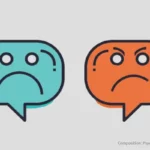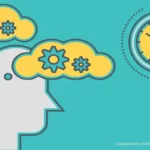
Have you ever felt so nervous that it seemed that the heart wanted to get out of the chest? In that case, it’s likely you suffered tachycardia for anxiety, a fairly common problem, although not always easy to detect, that can generate great alarm. In fact, a study conducted at the Massachusetts General Hospital revealed that one in three people will experience anxiety chest pain and palpitations at some point of their their lives.
Functional arrhythmias are a physiological disorder characterized by sudden reactions of the cardiac rate, without an apparent reason, and without an organic lesion. They tend to cross with high levels of anxiety and the cardiac rate can reach between 160 and 200 beats per minute, although in the clinical examinations no cardiac abnormality is detected. For that reason we make a reference to a functional disorder.
Anxiety tachycardia may be accompanied by anxiety chest pain, a feeling of difficulty in breathing, profuse sweating, nausea, and even anxiety dizziness.
How to recognize anxiety tachycardia?
Tachycardia due to anxiety can become so intense that the person believes he’s suffering a heart attack, although cardiologists assured him that he doesn’t suffer from any heart disease. Even so, the episode of palpitations is so intense that the person believes he will die from one moment to another, which further increases the anxiety and, therefore, the tachycardia.
After exposing ourselves to a stimulus that scares us in some way, it’s normal for our heart rate to increase.
However, if we become frightened and think we are losing control, our body will react as if it were a real emergency by further increasing the heart rate. In turn, this increase in heartbeat will scare us even more, creating a vicious circle in which, the more fear, the stronger the heart will beat.
Tachycardia due to anxiety is usually the result of exposure to a stressful, distressing, frightening or extremely sad situation. However, sometimes the simple memory or anticipation of such situations may be enough to trigger tachycardia. A thought or an emotion can also trigger palpitations, as well as an unconscious connection with some stimulus that we consider dangerous.
In fact, tachycardia for anxiety can be a learned response when in your mind you activate a certain topic that worries you or a stimulus present in different situations, although these in themselves aren’t threatening.
Since anxiety tachycardias are not always the direct and appreciable result of a stressful event, it is sometimes difficult for the person to establish the connection. Therefore, it’s important that you stop to analyze your environment and thoughts. Only then can you detect the triggers of anxiety. Then, you can activate them in your mind and notice how the palpitations are triggered. That is the confirmation that it is tachycardia for anxiety.
This situation can become highly disabling since, out of fear, the person can be increasingly confined at home, to avoid any kind of new stimulus or that can get out of his control, which will lead to increasingly lower threshold before which the anxious response is unleashed, generating a vicious circle.
Why does anxiety cause tachycardia?
There are two key brain areas for the processing of anxiety: the amygdala and the hippocampus. The amygdala is a center of communications between the different parts of the brain that process the incoming sensory signals and the areas that interpret these signals. It can alert the rest of the brain that a threat exists and trigger a response of fear or anxiety.
In the hippocampus, on the other hand, are stored many of the memories related to past experiences that are negative, stressful or anxious. The task of hippocampus is codifying the threatening events in memories.
When the brain encounters a threat (whether real or perceived), it releases a wave of neurotransmitters, such as cortisol and norepinephrine. These give us an extra boost, improve our perception, reflexes and speed to get safe, if necessary.
These neurotransmitters also cause the blood vessels to constrict and our heart pumps faster to make circulate more blood and oxygen through our body. basically, we enter the “survival mode”. Our sympathetic nervous system is activated, which acts as a kind of accelerator.
When the situation that generated that activation response has disappeared, the hypothalamus, another brain structure, should give the order that all systems return to normal. Then is activated the parasympathetic nervous system, which acts as a decelerator and helps us to relax and lower the heart rate (discover the vagus nerve and anxiety relation).
In fact, the increase in heart rate has a functional value and is not harmful, but if activated excessively it can end up causing damage to our body. If our systems don’t return to normal or are activated continuously, we have a problem.
Are anxiety palpitations dangerous?
Tachycardia due to anxiety is not usually dangerous, although is unpleasant. However, if the problem persists over time and you react with anxiety to a greater number of situations, it’s likely your cardiac coherence will end up being affected.
Scientists from Harvard University concluded that “when anxiety is present in excess or for long periods of time, it is considered harmful to mental and general health.” Anxiety has been associated with a higher incidence and, in some cases, with the progression of cardiovascular diseases.
The mechanisms of action of anxiety that can represent a risk for cardiovascular health are several.
– Autonomic dysfunction. The interruption in cardiovascular autonomic homeostasis, especially in regard to the body’s ability to maintain stability beat to beat and constant blood pressure, is a factor that affects overall cardiovascular health and increases the risk of mortality for this cause. People with a history of cardiovascular disease and hypertension who have a reduced ability to maintain autonomous stability have an increased risk of mortality. And it has been proven that people with anxiety disorders have a dysfunction in the body’s ability to regulate autonomic function.
– Inflammatory pathways. Inflammatory pathways play a key role in both the development and progression of heart disease. Anxiety disorders cause an increase of different inflammatory markers such as C-reactive protein, tumor necrosis factor-alpha, interleukin-6, homocysteine and fibrinogen.
– Endothelial dysfunction. Anxiety is also related to changes in the vascular endothelium. The vascular endothelium plays a key role in the health and maintenance of the circulatory system through the regulation of platelet activity, thrombosis, vascular tone and adhesion of leukocytes. Its dysfunction leads to the development of atherosclerosis. An increased endothelial dysfunction has been seen in people with an anxiety disorder.
– Platelet dysfunction. In addition, it has been shown that increased activity and activation of platelets by inflammatory triggers play a key role in atherothrombosis and myocardial ischemia. And people suffering from anxiety or acute stress also have greater platelet aggregation.
All this indicates that, although tachycardias due to anxiety will not cause a heart attack, in the long term they can have a harmful effect on cardiovascular health, so it’s important to stop them as soon as possible.
How to eliminate tachycardia due to anxiety?
There are different ways to treat anxiety and, therefore, eliminate the tachycardia it produces. The technique of detection and coping of the dreaded consequence is very effective because it focuses on detecting the triggers that provoke that anxiety and look for solutions to alleviate the symptoms, both on the physical and emotional levels.
To put it into practice you need to understand that discomfort is maintained when you try to avoid the consequences you fear so much. In other words, the first step is not to try to avoid those annoying sensations.
Basically, it means understanding that, although annoying, tachycardias are not dangerous in themselves. Thus you break the vicious circle, you calm the fear and you reduce the anxiety. To achieve this you need to look for alternative thoughts or behaviors:
– Breathing exercises. Deep breathing accompanies the heartbeat, generating a feeling of tranquility and well-being that will help you eliminate heart palpitations. Therefore, it is recommended that you learn breathing exercises that you can apply in any situation.
– Relaxation techniques. Jacobson’s progressive muscular relaxation tecnique is one of the most convenient exercises, because not only will you learn to relax but also to notice the body tension that precedes the anxiety episodes, so you can stop them before they go further.
– Positive thinking. It is not about falling into naive positivism but about developing more rational and adaptive thoughts. When you feel the palpitations, instead of thinking that you are going to die or suffer a heart attack, think it’s a reaction of fear and that you keep the control.
However, in some cases, when anxiety has been dragging on for years, it’s probably necessary to resort to psychological therapy. In addition, it’s always advisable to carry out a cardiological study to exclude a basic pathology.
Sources:
Celano, C. M. et. Al. (2016) Anxiety disorders and cardiovascular disease. Curr Psychiatry Rep; 18(11): 101.
Al-Ani, M. & Winchester, D. E. (2015) Prevalence and Overlap of Noncardiac Conditions in the Evaluation of Low-risk Acute Chest Pain Patients. Crit Pathw Cardiol; 14 (3): 97-102.
Pitsavos, C. et. Al. (2006) Anxiety in relation to inflammation and coagulation markers, among healthy adults: the ATTICA study. Atherosclerosis; 185(2): 320-326.
Harris, K. F. et. Al. (2003) Associations between psychological traits and endothelial function in postmenopausal women. Psychosom Med; 65(3): 402-409.
Gerritsen, J. et. Al. (2001) Impaired autonomic function is associated with increased mortality, especially in subjects with diabetes, hypertension, or a history of cardiovascular disease: the Hoorn Study. Diabetes Care; 24(10): 1793-1798.
Cohen, H. et. Al. (1998) Analysis of heart rate variability in posttraumatic stress disorder patients in response to a trauma-related reminder. Biol Psychiatry; 44(10): 1054-1059.
Fleet, R. P. (1996) Panic disorder in emergency department chest pain patients: prevalence, comorbidity, suicidal ideation, and physician recognition. Am J Med; 101(4): 371-380.
Levine, S. P. et. Al. (1985) Platelet activation and secretion associated with emotional stress. Circulation; 71(6): 1129-1134.



